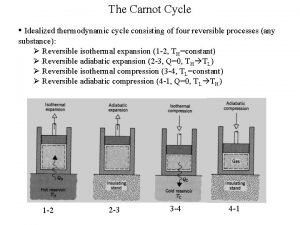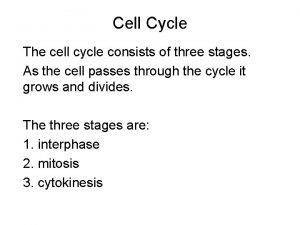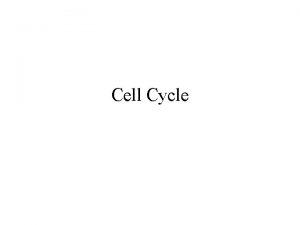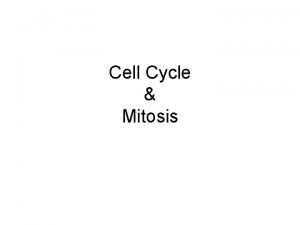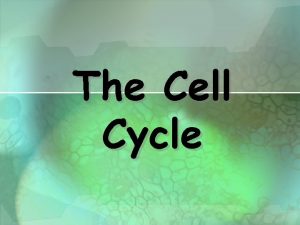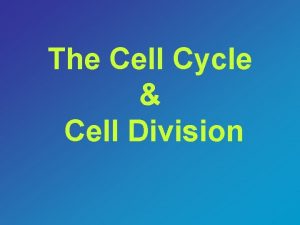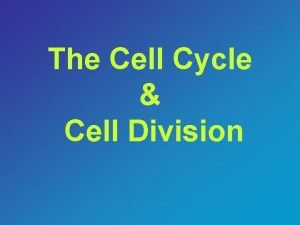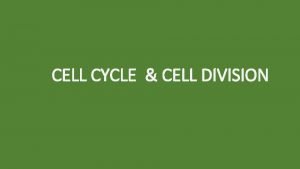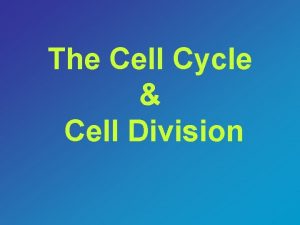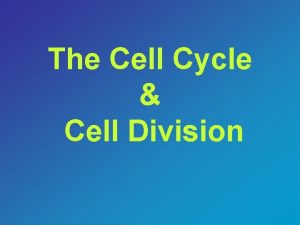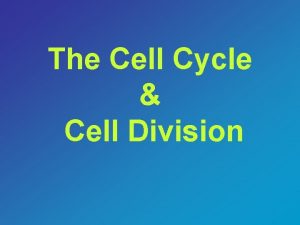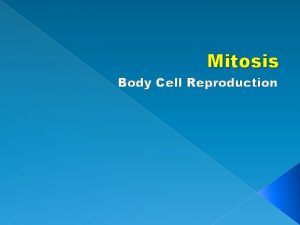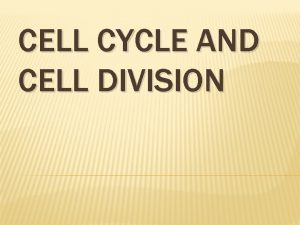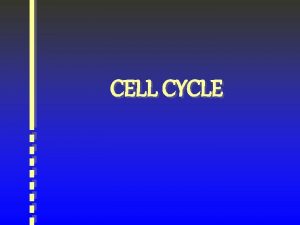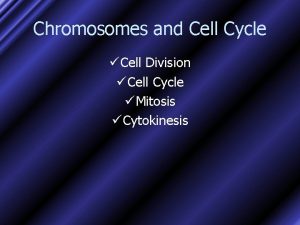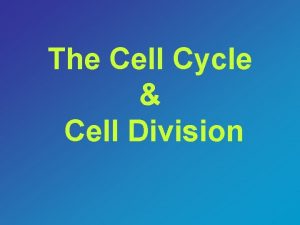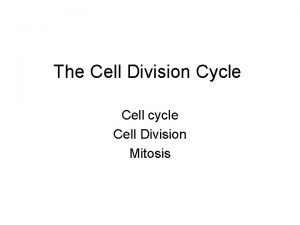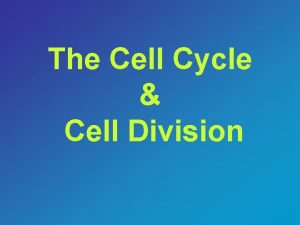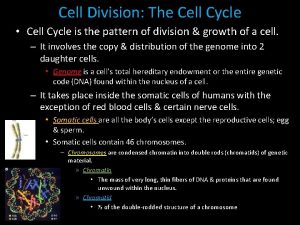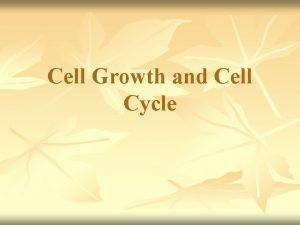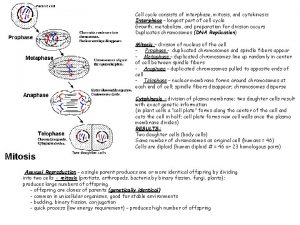Cell Cycle The cell cycle consists of three


































- Slides: 34

Cell Cycle The cell cycle consists of three phases: –Interphase, which has 3 stages (G 1, S, G 2) –Mitosis – division of nucleus, which consists of 4 stages (PMAT) –Cytokinesis – division of the cytoplasm

Mitosis • A single parent passes a complete copy of its genetic information to each of its offspring • Form of asexual reproduction – Somatic cells in humans reproduce this way. (Somatic cells = nerve, muscle, skin, blood, etc. )

Asexual Reproduction • Offspring formed through asexual reproduction are genetically identical to the parent. • Different types: – Binary fission – Budding – Fragmentation

Asexual Reproduction • Advantages: – Simplest, most efficient method of reproduction – Can produce a lot of offspring in a short amount of time without using a lot of energy • Disadvantages: – Cannot adapt easily to a changing environment, which may cause entire population to die out – No genetic variation in the populations

Sexual Reproduction • Two parents give genetic material to produce offspring. • Germ cells are specialized cells for reproduction. • The reproductive cells are called gametes. (Egg and sperm) • Which combine during fertilization to form a zygote. – A single cell that is produced by union of two gametes.

Chromosomes • Humans have 46 chromosomes or 23 pair – 44 of these chromosomes are called autosomal chromosomes, which means chromosomes that do not determine sex. – The other 2 chromosomes are sex chromosomes, X and Y. • Females are XX • Males are XY

Human Chromosomes

Chromosomes • When fertilization occurs, 2 cells combine to form a zygote. • This zygote can only have 46 chromosomes in humans. • But how can 2 cells combine and still have only 46 chromosomes? – Because gametes are formed through meiosis.

• Your cells have 23 pairs (46 total) of chromosomes: – 1 - 22 plus X from Mom – 1 - 22 plus X or Y from Dad • TOTAL = 46 chromosomes • Cells with two copies of each chromosome are diploid.

• Diploid organisms must produce specialized cells for reproduction – Gametes (egg/sperm) • Gamete cells are haploid – Cells with only ONE copy of each chromosome pair

Chromosome Number Diploid Haploid 2 n 1 n Cells that have 2 copies of each chromosome. Cells that have 1 copy of each chromosome. One copy came from mother cell and one came from father cell. The chromosome came from either the mother or the father.

Why Meiosis? • Meiosis is needed to produce haploid cells with unpaired chromosomes from diploid cells. • Haploid cells are needed for sexual reproduction. • Sexual reproduction is needed for genetic diversity.

Meiosis • A form of cell division that produces daughter cells with half the number of chromosomes that are in the parent cell. • Used only to make gametes • Occurs only in reproductive organs • Produces genetically different daughter cells.

Cell Types Somatic Cells These are body cells such as blood, skin, muscle, etc. Gametes These are cells that are used for reproduction. These cells are diploid in most These cells are haploid in most animals. These cells are produced by mitosis in most animals. These cells are produced by meiosis in most animals.

MEIOSIS

Meiosis • Germ cells spend most of their time in Interphase. • During the S phase of Interphase the DNA is replicated. • In Meiosis though, two divisions of the nucleus occur producing four cells. – Meiosis I and II

Meiosis I • Remember each of our cells are diploid, which means that we have 2 copies of the #1 -22 chromosomes (Mom & Dad) • The two copies of the #1 chromosome are called homologous chromosomes. – The same for the two copies of the #2, #3, #4, etc. – They are all homologous chromosomes.

Homologous Chromosomes • Homologous chromosomes are chromosomes that are similar in size, shape, and have the same genes on them. • In meiosis I, the 2 copies of each chromosome pair up with each other. Homologous Chromosomes

Homologus Chromosomes

Meiosis I • During meiosis I, the homologous chromosomes pair up and then are separated. Goes through PMAT • Forms 2 cells with half of the genetic material as the parent cell (haploid).

Meiosis II • These two cells then begin to divide again, but this time without an Interphase. – Why is that important? • Second division looks a lot like mitosis

Meiosis II • Chromosomes are separated into individual chromatids. (PMAT 2) • Results in four haploid cells genetically different from each other and their parent.

Why go to all this trouble? • Genetic Variation – Meiosis mixes up chromosomes in the gametes. • You can have any combination of chromosomes 1 – 22 in egg/sperm – One possible combination: 1, 2, 3, 4, 5, 6, 7, 8, 9, 10, 11, 12, 13, 14, 15, 16, 17, 18, 19, 20, 21, 22

Variety is the spice of life! • 223 possible combinations in just one egg/sperm by combining chromosomes randomly – 8, 388, 608 different egg/sperm can form as a result of meiosis! • Genetic variation is made possible by sexual reproduction and gives organisms an advantage.

Mix it up even more! • Genetic variation is the different combinations of genes found in a population. • 3 key contributions to genetic variation – Independent Assortment – Crossing Over – Random Fertilization

Independent Assortment • Occurs during metaphase I • Random separation of homologous chromosomes. – They can arrange so many different ways that the cells formed can have a variety of different chromosome combinations. • 8, 388, 608 possible gametes in parents

Independent Assortment

Crossing Over • Occurs during prophase I • The arms of homologous chromosomes can switch pieces (i. e. genetic material).

Crossing Over • Chromosomes can be formed that contain genes from both parents • Result: Unique, new assortment of genes! (genetic variation)

Random Fertilization • Any of these different sperm from an individual could fertilize any egg if they came into contact. • In humans, each parent could make about 8 million different gametes. • That give us 8 million x 8 million = almost 70 trillion possible children per couple!! That is why YOU are so unique!

Meiosis Square Dance

Life Cycle of Sexually Reproducing Organisms • Zygote: A single diploid cell that is produced by union of two gametes (egg and sperm in humans). • Repeated Cell Cycles (Mitosis): will form a multicellular organism, made of many genetically identical diploid cells. • Meiosis: will occur in specialized organs (ovaries and testes in humans) to produce gametes. • Fertilization: will join two gametes to produce zygote and the cycle starts again.


Methods of Reproduction Asexual Reproduction Sexual Reproduction One parent cell. Two parent cells. New cell will have same chromosome number as parent cell. New cell will have ½ the chromosome number of the parent cell. New cells contain the exact same DNA as the parent. New cells will contain a combination of DNA from both parents. Repeated mitosis Meiosis and Fertilization
 Great britain consists of three parts
Great britain consists of three parts Hci consists of three parts:
Hci consists of three parts: A font consists of three elements: typeface, typestyle, and
A font consists of three elements: typeface, typestyle, and Prophase spindle fibers
Prophase spindle fibers Carnot cykel
Carnot cykel Section 10-2 cell division
Section 10-2 cell division Cell cycle and cell division
Cell cycle and cell division Biology.arizona.edu/cell bio/activities/cell cycle/01.html
Biology.arizona.edu/cell bio/activities/cell cycle/01.html Cell cycle phases in order
Cell cycle phases in order Hát kết hợp bộ gõ cơ thể
Hát kết hợp bộ gõ cơ thể Lp html
Lp html Bổ thể
Bổ thể Tỉ lệ cơ thể trẻ em
Tỉ lệ cơ thể trẻ em Voi kéo gỗ như thế nào
Voi kéo gỗ như thế nào Glasgow thang điểm
Glasgow thang điểm Chúa sống lại
Chúa sống lại Các môn thể thao bắt đầu bằng tiếng đua
Các môn thể thao bắt đầu bằng tiếng đua Thế nào là hệ số cao nhất
Thế nào là hệ số cao nhất Các châu lục và đại dương trên thế giới
Các châu lục và đại dương trên thế giới Công thức tính độ biến thiên đông lượng
Công thức tính độ biến thiên đông lượng Trời xanh đây là của chúng ta thể thơ
Trời xanh đây là của chúng ta thể thơ Cách giải mật thư tọa độ
Cách giải mật thư tọa độ Làm thế nào để 102-1=99
Làm thế nào để 102-1=99 độ dài liên kết
độ dài liên kết Các châu lục và đại dương trên thế giới
Các châu lục và đại dương trên thế giới Thể thơ truyền thống
Thể thơ truyền thống Quá trình desamine hóa có thể tạo ra
Quá trình desamine hóa có thể tạo ra Một số thể thơ truyền thống
Một số thể thơ truyền thống Bàn tay mà dây bẩn
Bàn tay mà dây bẩn Vẽ hình chiếu vuông góc của vật thể sau
Vẽ hình chiếu vuông góc của vật thể sau Thế nào là sự mỏi cơ
Thế nào là sự mỏi cơ đặc điểm cơ thể của người tối cổ
đặc điểm cơ thể của người tối cổ Thứ tự các dấu thăng giáng ở hóa biểu
Thứ tự các dấu thăng giáng ở hóa biểu Vẽ hình chiếu đứng bằng cạnh của vật thể
Vẽ hình chiếu đứng bằng cạnh của vật thể Tia chieu sa te
Tia chieu sa te




